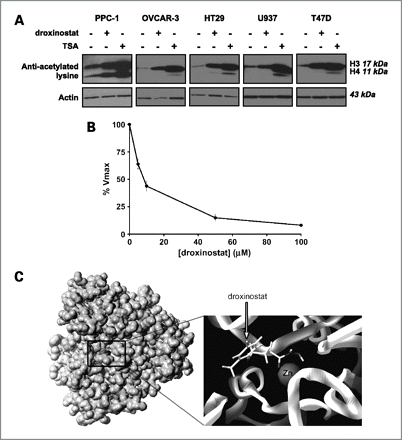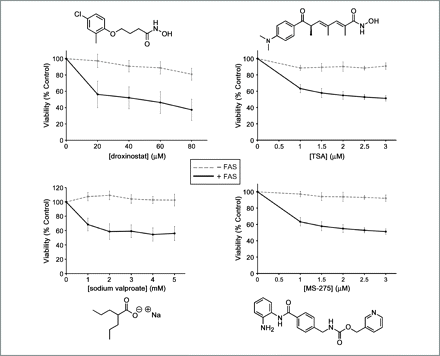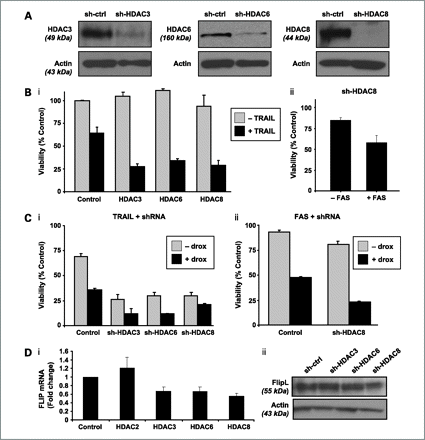
| Size | Price | Stock | Qty |
|---|---|---|---|
| 10mg |
|
||
| 25mg |
|
||
| 50mg |
|
||
| 100mg |
|
||
| 250mg |
|
||
| 500mg |
|
||
| Other Sizes |
|
Purity: ≥98%
Droxinostat (formerly NS-41080) is a novel, potent, selective inhibitor of histone deacetylase (HDAC) with potential anticancer activity. It exhibits >8-fold selectivity over HDAC3 and inhibits HDAC6 and HDAC8 with IC50s of 2.47 μM and 1.46 μM, respectively.
| Targets |
HDAC8 ( IC50 = 1.46 μM ); HDAC6 ( IC50 = 2.47 μM ); HDAC3 ( IC50 = 16.9 μM )
|
||
|---|---|---|---|
| ln Vitro |
|
||
| ln Vivo |
|
||
| Enzyme Assay |
HDAC inhibition is measured using crude nuclear extract from HeLa cells and the CycLex HDACs fluorometric assay, following the manufacturer's instructions (principally HDAC1 and HDAC2). (Treated sample fluorescence intensity / Control sample fluorescence intensity) × 100 represents the relative activity.
|
||
| Cell Assay |
PPC-1 cells (1 × 104) are seeded in 100 μL of 2.5% FCS-containing medium overnight into 96-well flat-bottomed plates. We add Droxinostat the following day. After adding CH-11 antibody (100 ng/mL), the cells are incubated for 24 hours. The 3-(4,5-dimethylthiazol-2-yl)-2,5-diphenyltetrazolium bromide (MTT) dye reduction assay is then used to determine the viability of the cells.
|
||
| Animal Protocol |
|
||
| References | |||
| Additional Infomation |
4-(4-chloro-2-methylphenoxy)-N-hydroxybutanamide is an aromatic ether.
|
| Molecular Formula |
C11H14CLNO3
|
|
|---|---|---|
| Molecular Weight |
243.69
|
|
| Exact Mass |
243.066
|
|
| Elemental Analysis |
C, 54.22; H, 5.79; Cl, 14.55; N, 5.75; O, 19.70
|
|
| CAS # |
99873-43-5
|
|
| Related CAS # |
|
|
| PubChem CID |
568416
|
|
| Appearance |
White to off-white solid powder
|
|
| Density |
1.252 g/cm3
|
|
| LogP |
3.153
|
|
| Hydrogen Bond Donor Count |
2
|
|
| Hydrogen Bond Acceptor Count |
3
|
|
| Rotatable Bond Count |
5
|
|
| Heavy Atom Count |
16
|
|
| Complexity |
225
|
|
| Defined Atom Stereocenter Count |
0
|
|
| SMILES |
ClC1C([H])=C([H])C(=C(C([H])([H])[H])C=1[H])OC([H])([H])C([H])([H])C([H])([H])C(N([H])O[H])=O
|
|
| InChi Key |
JHSXDAWGLCZYSM-UHFFFAOYSA-N
|
|
| InChi Code |
InChI=1S/C11H14ClNO3/c1-8-7-9(12)4-5-10(8)16-6-2-3-11(14)13-15/h4-5,7,15H,2-3,6H2,1H3,(H,13,14)
|
|
| Chemical Name |
4-(4-chloro-2-methylphenoxy)-N-hydroxybutanamide
|
|
| Synonyms |
NS 41080; NS41080; NS-41080
|
|
| HS Tariff Code |
2934.99.9001
|
|
| Storage |
Powder -20°C 3 years 4°C 2 years In solvent -80°C 6 months -20°C 1 month |
|
| Shipping Condition |
Room temperature (This product is stable at ambient temperature for a few days during ordinary shipping and time spent in Customs)
|
| Solubility (In Vitro) |
|
|||
|---|---|---|---|---|
| Solubility (In Vivo) |
Solubility in Formulation 1: ≥ 2.5 mg/mL (10.26 mM) (saturation unknown) in 10% DMSO + 40% PEG300 + 5% Tween80 + 45% Saline (add these co-solvents sequentially from left to right, and one by one), clear solution.
For example, if 1 mL of working solution is to be prepared, you can add 100 μL of 25.0 mg/mL clear DMSO stock solution to 400 μL PEG300 and mix evenly; then add 50 μL Tween-80 to the above solution and mix evenly; then add 450 μL normal saline to adjust the volume to 1 mL. Preparation of saline: Dissolve 0.9 g of sodium chloride in 100 mL ddH₂ O to obtain a clear solution. Solubility in Formulation 2: ≥ 2.5 mg/mL (10.26 mM) (saturation unknown) in 10% DMSO + 90% (20% SBE-β-CD in Saline) (add these co-solvents sequentially from left to right, and one by one), clear solution. For example, if 1 mL of working solution is to be prepared, you can add 100 μL of 25.0 mg/mL clear DMSO stock solution to 900 μL of 20% SBE-β-CD physiological saline solution and mix evenly. Preparation of 20% SBE-β-CD in Saline (4°C,1 week): Dissolve 2 g SBE-β-CD in 10 mL saline to obtain a clear solution. View More
Solubility in Formulation 3: ≥ 2.5 mg/mL (10.26 mM) (saturation unknown) in 10% DMSO + 90% Corn Oil (add these co-solvents sequentially from left to right, and one by one), clear solution. Solubility in Formulation 4: 30% propylene glycol, 5% Tween 80, 65% D5W: 30mg/mL |
| Preparing Stock Solutions | 1 mg | 5 mg | 10 mg | |
| 1 mM | 4.1036 mL | 20.5179 mL | 41.0357 mL | |
| 5 mM | 0.8207 mL | 4.1036 mL | 8.2071 mL | |
| 10 mM | 0.4104 mL | 2.0518 mL | 4.1036 mL |
*Note: Please select an appropriate solvent for the preparation of stock solution based on your experiment needs. For most products, DMSO can be used for preparing stock solutions (e.g. 5 mM, 10 mM, or 20 mM concentration); some products with high aqueous solubility may be dissolved in water directly. Solubility information is available at the above Solubility Data section. Once the stock solution is prepared, aliquot it to routine usage volumes and store at -20°C or -80°C. Avoid repeated freeze and thaw cycles.
Calculation results
Working concentration: mg/mL;
Method for preparing DMSO stock solution: mg drug pre-dissolved in μL DMSO (stock solution concentration mg/mL). Please contact us first if the concentration exceeds the DMSO solubility of the batch of drug.
Method for preparing in vivo formulation::Take μL DMSO stock solution, next add μL PEG300, mix and clarify, next addμL Tween 80, mix and clarify, next add μL ddH2O,mix and clarify.
(1) Please be sure that the solution is clear before the addition of next solvent. Dissolution methods like vortex, ultrasound or warming and heat may be used to aid dissolving.
(2) Be sure to add the solvent(s) in order.
 |
|---|
 |
 |